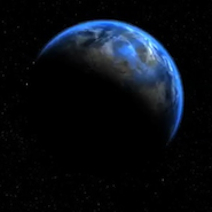It looks like the planetary system around the red dwarf Gliese 581 is not done yet with habitable worlds… The system has already been thought to be the first one harboring a habitable planet, in vain. But once again, it might turn out to be the case. With two candidates already discarded, a third planet, Gliese 581d, could be the first confirmed exoplanet that might support life.
In 2007, scientists reported the detection of two planets orbiting the red dwarf Gliese 581, not far from the edges of its habitable zone: in this area, planets are neither too cold, nor too hot to maintain liquid water on their surface (which is considered a requirement for life – as we know it – to develop). Quickly, the more distant planet Gliese 581d was judged to be too cold for life. The other planet, closer to the red dwarf, was thought to be potentially habitable. However, further analysis showed that liquid oceans would quickly evaporate in a “runaway greenhouse” effect, similar to the one that may have occurred on Venus.
Later, in 2010, another team of astronomers claimed they had discovered a new planet, Gliese 581g, also known as “Zarmina’s World”. According to the researchers, this planet was close to the center of the habitable zone and had a mass similar to that of Earth. After several months, various independent teams raised serious doubts about the planet’s existence: it is now believed that the planet might not exist at all, as the observation made may simply be some noise in the measurements.
Now, Gliese 581d might in the end become the first confirmed habitable alien planet. It is likely to be a rocky planet with a mass at least seven times that of Earth, and about twice as big. Because it receives less than a third of the stellar energy Earth does and may be tidally locked (the same side of the planet being constantly facing the star), the planet was thought to be too could to be habitable.
Robin Wordsworth, François Forget and colleagues from Laboratoire de Météorologie Dynamique (CNRS, UPMC, ENS Paris, Ecole Polytechnique) at the Institute Pierre Simon Laplace in Paris wanted to test this intuition. They developed a new computer model capable of accurately simulating possible exoplanet climates. The model simulates a planet’s atmosphere and surface in three dimensions, and allows a very wide range of conditions for the atmosphere content.

Surprisingly, the researchers found that with a dense carbon dioxide atmosphere, the climate of Gliese 581d would be stable and warm enough to have oceans, clouds and rainfalls. And such an atmosphere happens to be a likely scenario on such a large planet. Rayleigh scattering, which makes our sky blue, limits the amount of sunlight a thick atmosphere can absorb: an important part of the scattered blue light is reflected back to space. However, Gliese 581d is not affected by this phenomenon: the light of its parent star is red. In other words, the starlight can penetrate much deeper into the atmosphere, heating the planet thanks to the carbon dioxide atmosphere and carbon dioxide ice clouds predicted to form at high altitudes. There is one more thing: the simulations showed that the daylight heating was efficiently redistributed across the planet by the atmosphere, preventing atmospheric collapse on the night side or at the poles.
Another exciting detail is that Gliese 581 is a close neighbour. The star is only 20 light-years away from Earth, so in the future telescopes should be able to detect the planet’s atmosphere directly. Of course, the conditions might be completely different and the planet totally inhospitable, so the researchers developed a few tests that a future telescope should be able to perform.
Finally, if the exoplanet turns out to be habitable, it would still be quite different from what we know… Plunged into a perpetual red twilight, the planet would have a surface gravity about twice stronger than that of Earth. Anyway, that would surely be one of the most important discoveries ever made, and it would have important implications: if there are other habitable worlds, it is easy to imagine that life might exist somewhere else. If we were to find the evidence of life elsewhere, this would certainly change our view of the Universe.
Reference
Robin D. Wordsworth, François Forget, Franck Selsis, Ehouarn Millour, Benjamin Charnay, Jean-Baptiste Madeleine. Gliese 581d is the first discovered terrestrial-mass exoplanet in the habitable zone. The Astrophysical Journal, 2011; 733 (2): L48 DOI: 10.1088/2041-8205/733/2/L48

